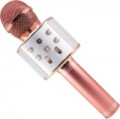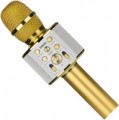Frequency range
The range of audio frequencies normally perceived and processed by a microphone.
The wider this range — the fuller the signal, the less likely that too high or low frequencies will be missed due to the imperfection of the microphone. However, in this case, it is worth considering some nuances. First of all: a wide frequency range in itself does not guarantee high sound quality — a lot also depends on the type of microphone (see above) and its frequency response, not to mention the quality of other components of the audio system. In addition, a large width is also not always really necessary. For example, for normal transmission of human speech, a range of 500 Hz — 2 kHz is considered sufficient, which is much narrower than the general range perceived by the human ear. This general range, in turn, averages from 16 Hz to 22 kHz, and also narrows with age. Do not forget about the features of the equipment to which the microphone is connected: it is hardly worth specifically looking for a model with an extensive range, if, for example, the amplifier to which it is planned to be connected severely “cuts off” the frequencies from above and/or below.
Sensitivity
Sensitivity describes the signal strength at the output of a microphone when it processes a sound of a certain volume. In this case, sensitivity means the ratio of the output voltage to the sound pressure on the membrane, expressed in decibels. The higher this number, the higher the sensitivity. Note that, as a rule, values in decibels are negative, so we can say this: the closer the number is to zero, the more sensitive the microphone. For example, a -38 dB model outperforms a -54 dB model in this parameter.
It should be borne in mind that high sensitivity in itself does not mean high sound quality - it only allows the device to “hear” a weaker sound. Conversely, low sensitivity is not an unequivocal sign of a bad microphone. The choice for this parameter depends on the specifics of the application: a sensitive device is useful for working with low sounds and in cases where it is necessary to capture the smallest nuances of what is happening, and a “weak” microphone will be convenient at high sound volume or, if necessary, filter out extraneous weak noises. There are models with
sensitivity adjustment(and for models with a headphone output
, headphone volume control may be provided).
Sound pressure
The maximum sound pressure perceived by the microphone, at which the harmonic oscillation coefficient does not exceed 0.5% — in other words, the highest sound volume at which no noticeable interference occurs.
The higher this indicator, the better the microphone is suitable for working with loud sound. Here it is worth considering that the decibel is a non-linear quantity; in other words, an increase in volume from 10 dB to 20 dB or from 20 to 40 dB does not mean a 2-fold increase in volume. Therefore, when assessing, it is most convenient to refer to comparative tables of noise levels. Here are some examples: a level of 100 dB roughly corresponds to a motorcycle engine or subway car noise; 110 dB — helicopter; 120 dB — the work of a demolition hammer; 130 dB, comparable to the sound of a jet aircraft taking off, is considered a pain threshold for a person. At the same time, many high-end microphones are able to work normally at a sound pressure of 140 – 150 dB — and this is a noise level that can cause physical damage to a person.
Features
—
Wireless connection. This feature is indicated for the so-called radio microphones — models in which the signal is transmitted wirelessly. Note that a radio microphone kit usually involves a receiver that is connected to an amplifier (or other sound processing device) in a classic wired way (see "Connection connectors"). However, the microphone itself is connected to the receiver via a radio channel.
—
Stereo recording. The ability to use a microphone to record sound in stereo format. This format assumes the presence of two channels, and for each of them the sound must be recorded separately; but the technical support of such a recording in different cases may vary. The most popular option is bi-directional microphones. However, in addition to this, this category includes paired sets for which the stereo recording function is directly claimed.
—
LPF (Roll-off). The presence of a low-pass filter in the design of the microphone (Roll-off is an alternative name for this function). This feature allows you to reduce the level of low frequencies in the signal produced by the microphone. This need may be due to two factors. Firstly, many extraneous noises are the sound of the wind, knocks on the device case, the surrounding background, etc. — are presented at low frequencies; by suppressing this range, you can significantly reduce the level of extraneous so
...unds “heard” through the microphone. Secondly, the LPF is useful for working with the so-called "proximity effect". This effect consists in the fact that when approaching the sound source, many models tend to increase the volume of the bass sound, and when removed, on the contrary, they fail the “bass”. By turning on Roll-off when approaching the sound source and turning it off when moving away, this effect can be smoothed out to a certain extent. For a number of technical reasons, this function is mainly used in condenser and electret microphones (see "Type"). Note that in advanced models, the low-pass filter can be made customizable and supplemented with an auxiliary ultra-low pass filter.
— Attenuator. The presence of an attenuator in the design of the microphone — a device that gradually attenuates the signal level at the output (a kind of opposite to an amplifier). This feature is useful when working with loud sound: by lowering the signal level, you can avoid overloading the system.
— Sensitivity adjustment. The presence of its own sensitivity control in the design of the microphone. This function allows you to adjust the signal level without using the controls in other components of the audio system — for example, to change the volume on the fly; this is quite convenient, since the microphone is usually at hand, and settings can be changed very quickly and without much hassle.
— Headphone volume adjustment. A separate knob for adjusting the volume of connected headphones (see "Headphone output"). Depending on the model, it can be placed both on the microphone itself and on the receiver for wireless connection. Anyway, this feature makes adjusting the volume more convenient: the control is at hand and the user does not need to reach for other devices or delve into the software settings.
— Mute the microphone. The presence of its own switch in the design of the microphone. In some use cases, it is not uncommon for situations where the microphone has to be constantly turned on and off. For example, during a concert, the number of performers may change, and it is better to turn off unused microphones; when communicating via Skype through a computer, sometimes you have to be distracted by conversations with others that the “computer” interlocutor does not need to hear, etc. Usually, muting the microphone is possible through the settings or control panel of the device to which it is connected; however, using your own switch is usually easier and faster, especially if you have to mute / unmute the sound frequently.
— Built-in memory. The presence of built-in data storage in the microphone eliminates the need to use external storage media to record sound. On-board storage is found in some models of advanced “lavaliers”, microphones for video cameras and voice recorders - i.e. in portable solutions with a view to comfortable work in the field.
— Switching DN. DN in this case means “directional pattern”, however, this function may mean switching not only between options for a unidirectional microphone (see “Directional Pattern”), but also between one-, two- and omnidirectional operation format (see “Directionality”). microphone"). Therefore, specific switching features and available options should be clarified for each model separately.
